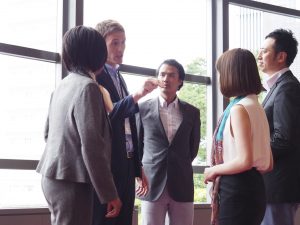Us Versus Them
How easy is it for an us-versus-them situation to arise? How often do we define our group as different from – and therefore better than – another group? The short answers: It’s surprisingly easy and it happens all the time.
In my professional life, I often saw us-versus-them attitudes arise between headquarters and the field. Staffers at head-quarters thought they were in a good position to direct field activities. People in the field thought the folks at headquarters just didn’t have a clue about the real world.
Headquarters and the field are typically separated by many factors, including geography, planning horizons, rank, age, academic experience, and tenure. Each side has plenty of reasons to feel different from – and superior to – the other side. But how many reasons does it take to generate us-versus-them attitudes?
In the early 1970s, the social psychologist Henri Tajfel tried to work out the minimum requirements for one group to discriminate against another group. It turns out that it doesn’t take much. People who are separated into groups based on their shirt color develop us-versus-them attitudes. People who are separated based on the flip of a coin do the same. Tajfel’s minimal group paradigm is quite simple: The minimum requirement to create us-versus-them attitudes is the existence of two groups.
Us-versus-them attitudes are completely natural. They arise without provocation. There’s no conspiracy. All we need is two groups. I sometimes hear managers say, “Let’s not develop us-versus-them attitudes here.” But that’s completely unnatural. Something about our human nature requires us to develop such attitudes when two groups exist. It can’t not happen.
We can’t avoid us-versus-them attitudes but we can dissolve them. We can’t stop them from starting but we can stop them once they have started.
The pioneering research on this was the Robbers Cave Experiment conducted in 1954. Muzafer and Carolyn Sherif, professors at the University of Oklahoma, selected two dozen 12-year-old boys from suburban Oklahoma City and sent them off to summer camp at Robbers Cave State Park. The boys were quite similar in terms of ethnicity and socioeconomic status. None of the boys knew each other at the beginning of the experiment.
The boys were randomly divided into two groups and housed in different areas of the campground. Initially, the groups didn’t know of each other’s existence. They discovered each other only when they began to compete for camp resources, like playing fields or dining halls. Once they discovered each other, they quickly named their groups: Rattlers and Eagles.
So far, the boys’ behavior was entirely predictable. The research question was: How do you change such behavior to reduce us-versus-them attitudes?
The researchers first measured the impact of mere contact. The researchers thought that by getting the boys to mingle – in dining halls or on camp buses, for example – they could overcome negative attitudes and build relationships. The finding: mere contact did not change attitudes for the better. Indeed, when contact was coupled with competition for resources, it increased friction rather than reducing it.
The researchers then moved on to superordinate goals. The two groups had to cooperate to achieve a goal that neither group could achieve on its own. For example, the researchers arranged for the camp bus to “break down”. They also arranged for the water supply to go dry. Rattlers and Eagles had to work together to fix the problems. The finding: cooperation on a larger goal reduced friction and the two groups began to integrate. Rattlers and Eagles actually started to like each other.
The research that the Sherifs started has now grown into a domain known as realistic conflict theory or RCT. The theory suggests that groups will develop resentful attitudes towards other groups, especially when they compete for resources in a zero-sum situation. According to Wikipedia, RCT suggests that “…positive relations can only be restored if superordinate goals are in place.”
The moral of the story is simple: you can’t prevent us-versus-them attitudes but you can fix them. Just find a problem that requires cooperation and collaboration.
More Thumb Thinking

Us versus them.
Remember heuristics? They’re the rules of thumb that allow us to make snap judgments, using System 1, our fast, automatic, and ever-on thinking system. They can also lead us into errors. Last time I wrote about heuristics (click here), we looked at three of the 17 different error categories: satisficing, temporizing, and availability. Let’s look at four more today.
Affect — what’s your first response? What’s your initial impression? What does your gut tell you? These are all questions about your affect heuristic — more commonly known as gut feel. System 1 usually has the first word on a decision. If you let System 1 also have the last word on the decision, you’re making an affect-based decision. It may be a good decision — or maybe not. If you want to double check the accuracy of your affect, you need to fire up System 2. People with “poor impulse control” often stick with System 1 only and don’t engage System 2.
Simulation — if it’s easy to imagine a given outcome, then it’s more likely that outcome will occur, right? Not necessarily. At least in part, it depends on how good your imagination is. Salespeople can use simulation to very good effect: “Imagine how you would feel in this new suit.” “Don’t you think it would be great to drive a car like this?” “Imagine what other people will think of you when they see you on this motorcycle!” Simulation simply invokes your imagination. If it’s easy to imagine something, you may convince yourself that it’s actually going to happen. You could be right or you could be a victim of wishful thinking. Before you make a big decision, engage System 2.
Representation — “She looks like my ex-girlfriend. Therefore, she probably acts like my ex-girlfriend.” You notice that there’s a similarity between X and Y on one dimension. Therefore, you conclude that X and Y are similar on other dimensions as well. You’re letting one dimension represent other dimensions. This is essentially a poor analogy. The similarity in one dimension has nothing to do with similarities in other dimensions. Generally, the more profound a similarity is, the more likely it is to affect other dimensions. Physical appearance is not very profound. In fact, it’s apparently only skin deep.
Us versus Them — “The Republicans like this idea. Therefore, we have to hate it.” Unfortunately, we saw a lot of this in our recent elections. In fact, politics lends itself to the us versus them heuristic — because politics often boils down to a binary choice. Politics is also about belonging. I belong to this group and, therefore, I’m opposed to that group. This is often referred to as identity politics and is driven by demonstrative (as opposed to deliberative) speeches. In warfare, the us versus them heuristic may be good leadership. After all, you have to motivate your troops against a determined enemy. In politics, on the other hand, it smacks of manipulation. Time to fire up System 2. (For my article on demonstrative and deliberative speeches, click here).
Do you see yourself in any of these heuristics? Of course you do. All of us use heuristics and we use them pretty much every day. It’s how we manage “reality”. Unfortunately, they can also trick us into mistakes in logic and judgment. As you become more aware of these heuristics, you may want to engage System 2 more frequently.
To prepare this article, I drew primarily on Peter Facione’s Think Critically. (Click here)
